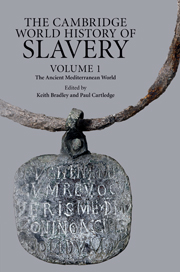Book contents
- Frontmatter
- Contents
- Series editors' introduction
- List of figures
- Acknowledgements
- Introduction
- 1 Slavery in the ancient Near East
- 2 Slaves in Greek literary culture
- 3 Classical Athens
- 4 The Helots: a contemporary review
- 5 Slavery and economy in the Greek world
- 6 The slave supply in classical Greece
- 7 Slavery and the Greek family
- 8 Resistance among chattel slaves in the classical Greek world
- 9 Archaeology and Greek slavery
- 10 Slavery in the Hellenistic world
- 11 Slavery and Roman literary culture
- 12 Slavery in the Roman Republic
- 13 Slavery Under the Principate
- 14 The Roman slave supply
- 15 Slave labour and Roman society
- 16 Slavery and the Roman family
- 17 Resisting slavery at Rome
- 18 Slavery and Roman material culture
- 19 Slavery and Roman law
- 20 Slavery and the Jews
- 21 Slavery and the rise of Christianity
- 22 Slavery in the late Roman world
- Bibliography
- General index
- Index of ancient passages cited
- Index of inscriptions and papyri
- Index of Jewish and Christian Literature Cited
8 - Resistance among chattel slaves in the classical Greek world
Published online by Cambridge University Press: 28 September 2011
- Frontmatter
- Contents
- Series editors' introduction
- List of figures
- Acknowledgements
- Introduction
- 1 Slavery in the ancient Near East
- 2 Slaves in Greek literary culture
- 3 Classical Athens
- 4 The Helots: a contemporary review
- 5 Slavery and economy in the Greek world
- 6 The slave supply in classical Greece
- 7 Slavery and the Greek family
- 8 Resistance among chattel slaves in the classical Greek world
- 9 Archaeology and Greek slavery
- 10 Slavery in the Hellenistic world
- 11 Slavery and Roman literary culture
- 12 Slavery in the Roman Republic
- 13 Slavery Under the Principate
- 14 The Roman slave supply
- 15 Slave labour and Roman society
- 16 Slavery and the Roman family
- 17 Resisting slavery at Rome
- 18 Slavery and Roman material culture
- 19 Slavery and Roman law
- 20 Slavery and the Jews
- 21 Slavery and the rise of Christianity
- 22 Slavery in the late Roman world
- Bibliography
- General index
- Index of ancient passages cited
- Index of inscriptions and papyri
- Index of Jewish and Christian Literature Cited
Summary
INTRODUCTION
The study of slave resistance raises particular problems of method. Our reconstructions are largely dependent on the ‘footprint’ left by resistance in the record produced by slave-owners. The size of that footprint may not accurately reflect the importance of the original phenomenon. Slave-owners can exaggerate the scale of potential resistance through paranoia or downplay it to reassure themselves. Or they may have little interest in recording it at all. Different authors, even different texts, can have different intentions. Interpreting the scattered traces and disentangling dream, nightmare and reality are far from straightforward. The (sparse) evidence often allows more than one interpretation. One of the aims of this chapter is to reveal the ambiguities that can sometimes be lost in more general discussions.
SLAVE REBELLION AND THE PROBLEM WITH NARRATIVE SOURCES
Little evidence of slave rebellion survives from the classical Greek world. The encyclopaedist Athenaeus of Naucratis in Egypt, writing around ad 200, discusses (265d–266e) a band of runaways led by Drimacus on the island of Chios. The date could range from the seventh to the third centuries bc. Drimacus made a truce with the local slave-owners limiting the scale of future raiding and flight. Eventually, however, the Chians turned on him. He persuaded his (male) lover to deliver his head to the slave-owners and claim the reward offered (and freedom). The Sicilian city of Syracuse experienced a slave revolt during a siege between 415 bc and 413 bc.
- Type
- Chapter
- Information
- The Cambridge World History of Slavery , pp. 153 - 175Publisher: Cambridge University PressPrint publication year: 2011
- 7
- Cited by



